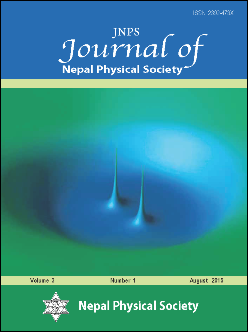Free Energy of Mixing of some Binary Liquid Alloys
DOI:
https://doi.org/10.3126/jnphyssoc.v3i1.14449Keywords:
Binary liquid alloy, Free energy of mixing, Strongly interacting system, Successive numerical approximations methodAbstract
Binary liquid alloys often show interesting behaviour as regards their thermodynamic properties. The heat of mixing often bears a large negative value and the entropy of mixing an S-shape. The free energy of mixing becomes asymmetric around the equi-atomic composition especially in case of complex forming alloys. In the present theoretical work we have tried to compute the free energy of mixing of some binary alloys e.g. lithium-lead, potassium amalgam and magnesium-tin―all in liquid state near their respective melting points. All these alloys form strongly interacting systems. So, we have applied Flory’s model which is a statistical mechanical model considering the size factor of the constituent species of a binary liquid alloy. We have ignored the interaction between the complex and each ingredient within an alloy and amended the formula accordingly. In the light of observed activity of a metal within an alloy we have ascertained the interchange energy by the method of successive numerical approximations and then calculated the free energy of mixing according to the said model for different concentrations of the ingredients. Our results explain the observed anomaly in the free energy of mixing of the present liquid alloys.
Journal of Nepal Physical Society Vol.3(1) 2015: 97-101
Downloads
Downloads
Published
How to Cite
Issue
Section
License
All right reserved. No part of this Journal may be reproduced in any form or by any electronic or mechanical means, including information storage and retrieval system, without permission in writing from the publisher, except by a reviewer who may quote brief passage in a review. The views and interpretation in this journal are those of author(s) and they are not attributable to the NPS.




